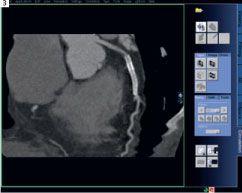- AI
- Molecular Imaging
- CT
- X-Ray
- Ultrasound
- MRI
- Facility Management
- Mammography
Reliable In-Stent Lumen Visualization With Dual Source CT Coronary Angiography
A 58-year-old man with a history of hypertension and hypercholesterolemia was admitted to the hospital with symptoms of suspected stable angina pectoris. The patient was referred to conventional coronary angiography after a positive exercise-ECG test. Conventional angiography showed significant stenoses at the level of the proximal right coronary artery (RCA) and the proximal left anterior descending coronary artery (LAD). Percutaneous intervention was undertaken and one bare-metal stent in the RCA and two overlapping bare-metal stents in the LAD were successfully implanted. The patient was referred to follow-up CT coronary angiography after 18 months.
HISTORY
A 58-year-old man with a history of hypertension and hypercholesterolemia was admitted to the hospital with symptoms of suspected stable angina pectoris. The patient was referred to conventional coronary angiography after a positive exercise-ECG test. Conventional angiography showed significant stenoses at the level of the proximal right coronary artery (RCA) and the proximal left anterior descending coronary artery (LAD). Percutaneous intervention was undertaken and one bare-metal stent in the RCA and two overlapping bare-metal stents in the LAD were successfully implanted. The patient was referred to follow-up CT coronary angiography after 18 months.
DIAGNOSIS
The patient was scanned on a Dual Source CT (DSCT) scanner. Nitroglycerine was administered prior to the CT scan; however, the patient did not receive prescan beta-blockers. The patient had a heart rate of 76 beats/minute during the CT scan. DSCT coronary angiography was able to reliably rule out the presence of in-stent restenosis in both the RCA and LAD stents.
PROTOCOL
Scanner SOMATOM Definition
Scan area Heart
Scan length 103 mm
Scan time 7,3 sec
Scan direction Caudo-cranial
Heart rate 76 bpm
kV 120 kV
mAs / Rot 400 mAs/rot
Rotation time 0.33 sec
Temporal resolution HR independent 83 msec
Slice collimation 0.6 mm
Spatial resolution 0.33 mm
Pitch 0.32
Reconstructed slice thickness 0.75 mm
Increment 0.4 mm
Prospective ECG-tube modulation On, window: 30–60%
CTDIvol 45,31 mGy
Kernel B46f
Contrast material volume 90 ml
Flow rate 5,5 ml/s
Bolus tracking On

Volume-rendered CT image (Fig. 1) showing the stents in the proximal-to-mid LAD and the mid part of the RCA.

Curved multiplanar CT images showing excellent visualization of the in-stent lumen of both the RCA (Fig. 2) and LAD (Fig. 3) stents, thereby reliably ruling out the presence of in-stent restenosis.

Curved multiplanar CT images showing excellent visualization of the in-stent lumen of both the RCA (Fig. 2) and LAD (Fig. 3) stents, thereby reliably ruling out the presence of in-stent restenosis.
Computed Tomography Study Assesses Model for Predicting Recurrence of Non-Small Cell Lung Cancer
January 31st 2025A predictive model for non-small cell lung cancer (NSCLC) recurrence, based on clinical parameters and CT findings, demonstrated an 85.2 percent AUC and 83.3 percent sensitivity rate, according to external validation testing in a new study.
What Emerging CT Research Reveals About Obesity and Post-Op Survival for Non-Small Cell Lung Cancer
January 29th 2025For those without low skeletal muscle mass on CT and myosteatosis, obese patients have a 23 percent lower risk of death than non-obese patients after undergoing curative resection for non-small cell lung cancer, according to newly published research.
